|
|
| Overview |
All formal changes, regardless of their type, have the same functionality and available options.
| General Information |
Serves as a "Cover Page" for the Change (Type, Reason, Description, Priority) |
| Affected Items |
Each change can have an unlimited number of affected items. These represent the actual items (Parts, BOMs, Documents, etc.) that will be affected by the formal change. For each affected item, you can define whether or not a revision change is warranted and its material disposition |
| Actions |
A list of additional actions (BOM, Document, Vendor, Attribute, General, etc. changes/redlines) that need to occur to the Affected items |
| Attachments |
Additional documents (such as rework instructions) required to describe the requested change |
| Attributes |
Additional fields/parameters to help define the change information |
| History |
This is where Omnify captures the date, time, and other metadata associated with the creation and modification of the Change/ECO |
| Comments |
User comments |
| Signoff |
A list of users who are to review and/or signoff on the requested change |
Each "Change Type" can contain different rules for the change (forced rev change, signoff users, rollup options, etc.)
The ECO/Change Options page allows you to modify the following:
| • | Change Types |
| • | Change Priorities |
| • | Material Locations |
| • | Disposition Actions |
| • | Miscellaneous Options |
You can change the data set by selecting an available option in the drop list.

You can change the data set by selecting an available option in the drop list.
|
 |
Change Types |
Top |
|
The Change Types option allows you to create a list of Change Types that are used to define and classify formal change requests.
For each Type you can define a different set of rules, which are applied when implementing a change.
Change types can be included as criteria for automatic signoff workflow assignment.
You can also change the type of a formal change dynamically to fit your own Formal change process.
To modify Change/ECO types, select the Change Types option from the drop list.

Change Type options will be available when defining the formal change in Omnify Desktop (General tab).


To add a change type, click the Add toolbar button.
This will present the New Change Type dialog box.

When defining a change type, you can set the following fields/options:
| Name |
Change type label/identifier |
| Description |
Description of change type |
| Number Prefix |
Prefix to be used for the Auto Number scheme |
| Autonumber Group |
Change number scheme to be used for the change type |
| Bump Revisions on Affected Items |
Define whether or not affected items automatically appear as rev changes when added |
| Run Rollup on Affected Items |
Define whether or not the affected item rollup will automatically run when affected items are added |
Once all fields/options are set, click the Apply or Add button to create the change type.
To modify a change type, click the Edit hyperlink in the Actions column.
This will present the Edit Field dialog box.
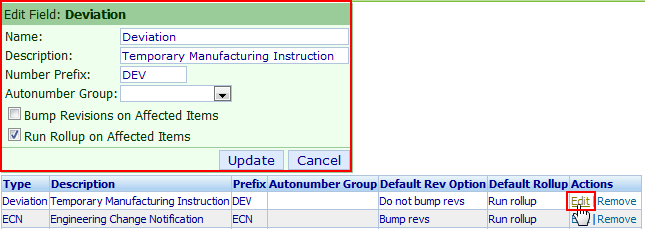
Once the desired changes are made, click the Update button to save the changes.
To remove a Change Type, click the Remove hyperlink in the Actions column.

|
 |
Change Priorities |
Top |
|
The Change Priorities option allows you to define a list of Priorities that are used to define and classify the importance of formal change requests.
To modify Change/ECO Priorities, select the Change Priorities option from the drop list.

Change Priorities options will be available when defining the formal change in Omnify Desktop (General tab).

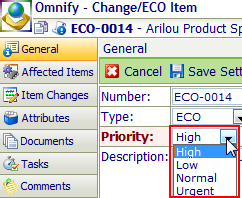
To add a change priority, click the Add toolbar button.
This will present the New Priority dialog box.
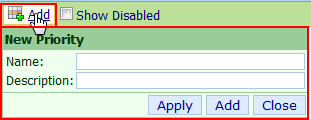
When defining a change priority, you can set the following fields/options:
| Name |
Priority label/identifier |
| Description |
Description of priority |
Once all fields/options are set, click the Apply or Add button to create the change priority.
To modify a change type, click the Edit hyperlink in the Actions column.
This will present the Edit Field dialog box.
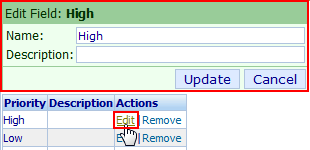
Once the desired changes are made, click the Update button to save the changes.
To remove a Change Priority, click the Remove hyperlink in the Actions column.

|
 |
Material Locations |
Top |
|
The Material Locations option allows you to define a list of options that can be used to define and classify the disposition of the affected material for a given formal change.
To modify material location fields, select the Material Locations option from the Options list.

Material Locations define physical or virtual locations or areas for material.
You can define up to 10 different Location fields.

Disposition Locations will appear as separate columns in the Affected Items list of the Change/ECO form.

When adding or editing affected items, you will be able to define the disposition values.

To enable a Material Location field, specify a location name in the Name column.

Then click the Enable checkbox.

When defining the field, you can define the field value type to be either User Edit or Pick List.

Once the fields are defined, click the Save Settings toolbar button.

For Pick List fields, you can define the field values by clicking the Set Values hyperlink.

This will launch the Field Values dialog box.
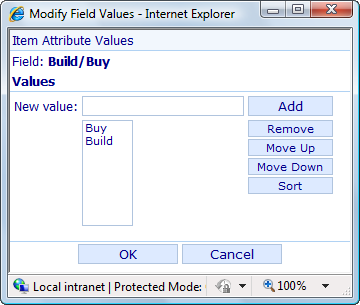
To add values, type the new value in the New Value field and then click the Add button.
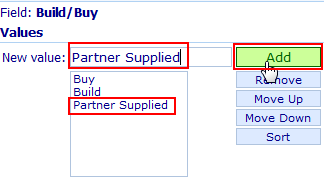
Note: you can specify multiple values to be added at once using a semi-colon as a delimiter.


To remove values, select the entries in the Values list and click the Remove button.


You can change the order by selecting the entries and clicking the Move Up and Move Down buttons.
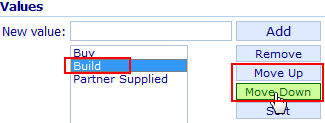
You can sort the list alphabetically by clicking the Sort button.
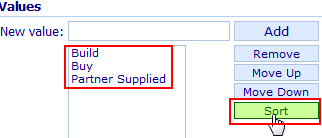
|
 |
Disposition Actions |
Top |
|
The Disposition Actions option allows you to define the available field values for the Material Location fields to define Material Disposition for affected items.
To modify Disposition Actions, select the Disposition Actions option from the drop list.

Disposition Action options will be available when defining Material Disposition fields for affected items on Changes/ECOs.


To add a disposition action, click the Add toolbar button.
This will present the Disposition Action dialog box.

When defining a disposition action, you can set the following fields/options:
| Name |
Disposition Action label |
| Description |
Description of Disposition Action |
Once all fields/options are set, click the Apply or Add button to create the change priority.
To modify a disposition action, click the Edit hyperlink in the Actions column.
This will present the Edit Field dialog box.
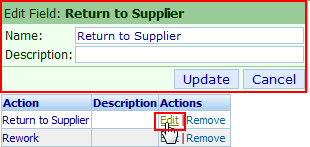
Once the desired changes are made, click the Update button to save the changes.
To remove a Disposition Action, click the Remove hyperlink in the Actions column.

|
 |
Miscellaneous Options |
Top |
|
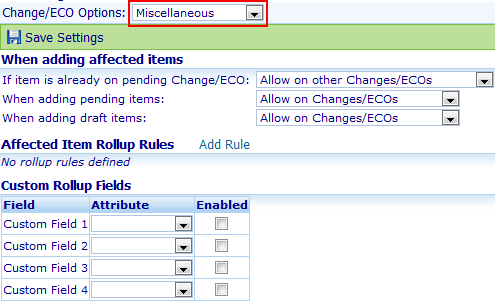
The Miscellaneous Options Page contains 3 main sections:
• Adding Affected Items
• Affected Item Rollup Rules
• Custom Rollup Fields
When changes are made to any of the options, you will need to click the Save Settings button to store the changes.

The Affected Items contains the following options:

| If item is already on pending Change/ECO |
Allow on other Changes/ECOs |
If this option is selected, you will be able to place an item on multiple pending Changes/ECOs at the same time. |
| Do not allow on other Changes/ECOs |
If this option is selected, you will not be able to raise another Change/ECO against an item if it already exists on another pending Change/ECO. |
| When adding pending items |
Allow on Changes/ECOs |
If this option is selected, you will be able to place pending items on Changes/ECOs. |
| Do not allow on Changes/ECOs |
If this option is selected, you will not be able to place pending items on Changes/ECOs. |
| When adding draft items |
Allow on Changes/ECOs |
If this option is selected, you will be able to place draft items on Changes/ECOs. |
| Do not allow on Changes/ECOs |
If this option is selected, you will not be able to place draft items on Changes/ECOs. |
The Affected Item Rollup Options allow you to define Rules that will be applied to rollup items to have specific items be ignored when the Automatic Rollup runs.

To define a new rule, click the Add Rule button.
This will display the Rollup Rule dialog box.
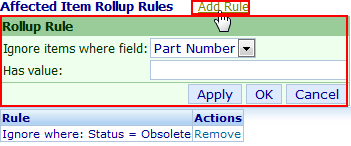
From the Rollup Rule dialog box, select a field to ignore items.

And then specify a value to ignore, and then click the OK or Apply button to create the rule.
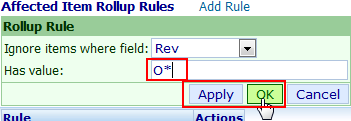
You can enable Attribute fields to be included in the Rollup.
To enable attribute fields, select an Attribute from the drop list, and click the Enable checkbox.

These fields can be used in rollup options and will be visible when the Affected Item Rollup is invoked.
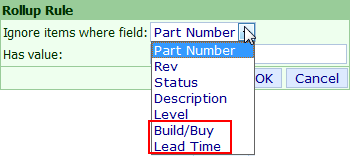
|
|